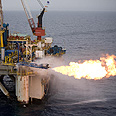
Tamar-1 drilling site
צילום: "אלבטרוס"
Report: Israel stealing Lebanese gas
As-Safir analyst says newly discovered Leviathan gas site extends into Lebanese territorial waters, believes Lebanon will defend its rights at site, meaning affair could lead to new conflict between Israel, its northern neighbor
Days after a major natural gas find was reported at the Leviathan site off the coast of Haifa, elements in Lebanon were quick to claim that Israel is stealing the gas from its neighbor to the north.
London-based as-Safir newspaper said on Tuesday that the reserve which was found "extends into Lebanon's territorial waters, which forces on Lebanon a new challenge and introduces a new issue to struggle over." The paper also published maps supporting its claims.
Hilmi Moussa, as-Safir's Israel affairs analyst, relying on Israeli reports, said, "The region where the find was made lies mostly off the Lebanese shores and in international waters between the sea border of Palestine and the sea border of Cyprus.
"However, Israel has received a guarantee from Britain, which has no rights in Palestine, to search for oil in the area near the Lebanese shores. The map of deposits, as published in the Israeli economic papers, shows the scope of the deviation into Lebanon's international rights."
Moussa, whose report appeared on the front page of the newspaper under the headline: "Israel preparing to steal gas fields in Lebanon's waters", goes on to say, "If these preparations and studies are true – the region will quickly turn into a new conflict between Israel and Lebanon, which will defend its rights in the water.
"This means that international interest in the region, and its economic aspects, will increase, just only due to the scope of the amount of gas, but also due to its proximity to European shores."
The analyst added, "the drill sites, 'Rut', 'Tamar', 'Leviathan' and 'Alon' are included in areas that penetrate sites off of the Lebanese shores or in areas that are situated very far away from the shores of Israel.
"The data show that the companies Nobel Energy and Delek received privileges from Israel to drill at the sites Alon A. and Alon B. which extend to the shores of Cyprus, and that Nobel Eneregy is not hiding the fact that the research it is basing its assessments on covers an area by the name of Block 12 in Cyprus' waters."
The State's profits from the recently discovered drilling site are estimated to reach some NIS 130 billion ($33.7 billion) for the duration of its extraction period, which is expected to last some 50 years.
This means annual income from the deposits should range from NIS 2.5 billion to NIS 3 billion ($650 million to $780 million).










